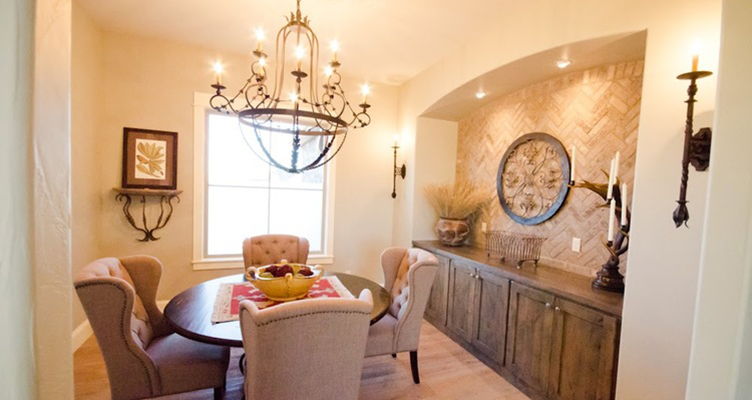All Tharp stain applications incorporate multiple hand sanding operations and a hand rubbed process for a beautiful finish. Proper care of your cabinet finish will ensure years of beauty.

Homeowner's Guide to Cabinet Care and Cleaning
Wondering how to keep your new custom cabinetry from Tharp looking beautiful? We can help! Follow these simple instructions:
Dust them periodically, keep them clean by using a soft lint-free cloth, — or a microfiber cloth for laminate and high gloss cabinetry — AND THAT’S IT!
NEED TO FIGHT SOME GRIME?
Usually, a clean, soft cotton cloth —or microfiber cloth for laminate and high gloss cabinetry — dampened with warm water will do the trick!
For extra grime fighting, a mild solution of dishwashing liquid (not dishwasher products) mixed with fresh, clean, warm water will take care of dirt and grease. 5% dishwashing liquid to 95% water is a good ratio.
After cleaning your stained or painted cabinets, wipe them down with a clean, damp cloth and be sure to dry wet/damp surfaces with another clean soft cloth.
Laminates and high gloss materials MUST be dried with a microfiber cloth to avoid scratches.
WHAT ABOUT SPLATTERS AND SPILLS?
Make sure to wipe them up quickly! Then, clean as needed with warm water or the mild dishwashing liquid solution. Prolonged exposure to food, water and other liquids, as well as grease and oil splatters can cause permanent damage or discoloration to your cabinet’s finish.
Don’t forget to dry after cleaning, using a soft, clean cloth for stained and painted cabinetry. Dry laminates and high gloss cabinets with a microfiber cloth.
GLASS DOOR CARE
Clean the glass by spraying an ammonia-free glass cleaner on a clean, soft, lint-free cloth or paper towel, and wiping down the glass. Don’t spray glass cleaner directly on the glass to avoid seepage behind mullions or dividers, which could cause damage to the wood or other materials.
SHOULD I POLISH OR WAX?
Neither!
Your cabinets don’t require waxing and we don’t recommend it. Over time, waxing and polishing compounds may build up on cabinet surfaces forming a hazy, streaked or yellowed appearance. Wax build up is really hard to remove — no one has time for that!
OTHER THINGS TO BE AWARE OF
Don’t drape damp dishtowels or clothes over your cabinet doors. Moisture can cause permanent damage, like peeling and discoloration to the cabinet finish. Dry wet surfaces immediately using a soft, clean cloth.
More on the topic of moisture: Wood will expand and contract based upon the amount of moisture in the home. Maintaining a consistent temperature and humidity level is key to cabinet health. Do not place steam emitting home appliances such as coffee pots, instant pots, and rice cookers directly under cabinets when these appliances are in use. Steam vented from dishwashers needs to be wiped down on wooden dishwasher panel to avoid excessive moisture to collect on these wood surfaces.

Heat from the self-cleaning oven feature is much greater than normal cooking temperatures, and could potentially damage surrounding cabinetry. While it is a rare occurrence, minimize the risk of cabinet damage by removing cabinet doors and drawers closest to the oven before using the self-cleaning feature.
Direct sunlight tends to darken the color of natural wood products, with the exception of walnut, which will lighten. Painted wood surfaces and laminates, including high gloss are also suspect to fading or discoloration. Draperies or blinds are the best defense to shield cabinetry from direct sunlight.
PRODUCTS TO AVOID
- Harsh detergents, strong soaps, multi-purpose and abrasive cleaning products:
- Tub and sink cleaners
- Scouring powders and scouring pads
- Steel wool or self-polishing waxes
- Sponges or dish cloths. They could contain particles that could scratch your cabinets, as well as food, oil residue or remnants of harsh cleaning solutions.
- Paper towels or similar products especially for high gloss cabinetry, due to the ease of scratching
- Solvent based or petroleum based products such as mineral spirits, nail-polish removers or paint thinners.
- Ammonia, bleach or cleaning products that contain either ammonia or bleach.
- Silicone based cleaning, waxing or polishing products.
HOW TO ALIGN CABINET DOORS
Cabinet doors can get out of alignment over time due to usage. The good news is that you can easily fix them with some minor adjustments. Explore this short video on how to adjust euro-style hinges on your doors.
